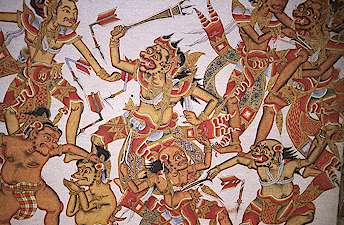|
|
|
Art in Bali The Balinese, though famous throughout the world for their dance, painting, and sculpture, never had the word 'art' in their own vocabulary. Likewise, the word 'artist' or 'craftsman' didn't
exist in Balinese. |
|
|
Sculpture is a good example of art in Bali.
It's everywhere. Sculpture is created on public buildings, for the gods. It's considered
functional, as a part of life, not as something separate. The carvings are done in volcanic rock, known as paras, which is
excellent for detail, because of its' softness. With the growth of tourism and hotels, carvings are more prolific than ever. Artists have expanded from purely religious themes, to more commercial ones, like dogs and lanterns. |
| Painting is another famous art of Bali. Before the 1920,
there were very few paintings that were not religious in nature. Since the advent of tourists, however, many schools of painting have developed. Hindu themes are still popular, as are scenes of nature and village life. |
 |
|
Balinese carving and painting skills are also applied to wood. Statues, furniture, ornamentation, and masks are seen everywhere in Bali. In particular, the masks of Bali have become world famous. Many Balinese dances require masks, such as this Barong, carved from wood, then painted and decorated. |
| The Balinese have never bothered to compartmentalize their
lives. Art, then, is not something that is hung on a wall or put in a cabinet. Offerings, cloth, and architecture fit in this mode of thinking, as well. It's difficult to find any phase of Balinese life that could not, by western standards,
be called 'art'. This is probably the great lesson that Bali offers to the world:
|
|